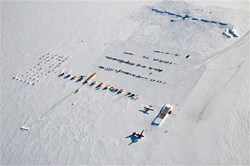|
What's it like to live more than 900 miles (nearly 1,500 kilometers) from McMurdo Station in West Antarctica? The video podcast Life @ Byrd Surface Camp, Podcast #5 in a series produced by the POLENET project, describes life at the camp during the 2009-2010 field season. The Polar Earth Observing Network (POLENET) is a network of Global Positioning System (GPS) and seismic stations in Antarctica and Greenland that measures changes in the ice sheets as they respond to climate change. The measurements will help answer critical questions about ice sheet behavior in a warming world and can be used to predict sea level rise accompanying global warming and to interpret climate change records. The GPS stations measure vertical and horizontal movements of bedrock, while the seismic stations characterize physical properties of the ice-rock interface, lithosphere, and mantle. Combined with satellite data, the data offer a more complete picture of the ice sheet's current state, potential changes in the near future, and its overall size during the last glacial maximum. These data will also be used to infer sub-ice sheet geology and the terrestrial heat flux, critical inputs to models of glacier movement. The project is an International Polar Year To learn more, visit the POLENET web site
|



For USAP Participants |
For The Public |
For Researchers and EducatorsContact UsNational Science FoundationOffice of Polar Programs Geosciences Directorate 2415 Eisenhower Avenue, Suite W7100 Alexandria, VA 22314 Sign up for the NSF Office of Polar Programs newsletter and events. Feedback Form |


